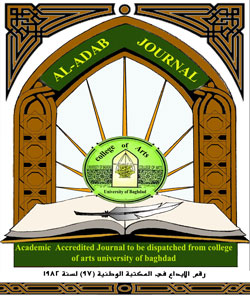Stylistic changes in the documentary
(Director Michael Moore as a model)
DOI:
https://doi.org/10.31973/aj.v0i134.1021Keywords:
stylistic changes, documentary, cinematography, director Michael MooreAbstract
The stylistic changes that occurred in the documentary film were not addressed by researchers in cinematic studies in Iraq, As well as being useful for scholars and those working in the field of cinematic art, As it was necessary for the cinema that originated through shows of bars, popular theaters and movie clubs Cinematic, To acquire a cultural level, and to become an educational and scientific instrument used in various aspects of life, The term method is often used to denote the reference to new, effective and eloquent treatment in selecting and employing linguistic techniques and means to express thought that is embodied in a live interaction with the recipient in a way that he realizes that this expression has acquired a method that can only be devised by this creator, Therefore, the determination of the method stems mainly from the expressive value of the aesthetically employed component within the structure of the artwork, Through its distinction within the framework of the artistic achievement, the artist’s style is indicated, in addition to what the nature of the age and the intellectual and ideological directions it contains give him a basis that prints the style and gives him a general framework that guides the artist’s directions.
Downloads
References
Al-Masdi, Abd Al-Salam (without history): Al-Tariqiya and Al-Style, the Arab House for Book.
Al-Shayeb, Ahmed (1953): The Origins of Literary Criticism, The Egyptian Renaissance Library, Cairo.
Anthony, Macle Anglo (1999): Building a Vision, translated by: Abiya Hamzawy, The General Film Foundation, Damascus.
Bergero (1994): stylistics, translated by: Munther Ayashi, Syria, Center for Cultural Development.
Boggs, Joseph M. (1995): The Art of Watching Movies, translated by: Widad Abdullah, The Egyptian Gift for Books, Cairo.
British Encyclopedia (Britannica) (2003): CD, Microsoft Corporation Edition.
Chandler, Sh. (1999): Anna Fellini, translation: Aref Garden, The General Cinema Foundation, Damascus.
Fadl, Salah (1993): The Science of Method - Principles and Procedures, Mokhtar Publishing and Distribution, Cairo.
Grammon, Robert Lavon (Without History): Contemporary Cinema, see: Moussa Badawi, Cairo, Al-Ahram Press.
Ibn Khaldun, Abd Al-Rahman Muhammad (1960): Introduction to Ibn Khaldun, published by: Ali Abd Al-Wahid Rafi, Cairo.
Ibn Manzur, Abu Al-Fadl Jamal Al-Din Muhammad Ibn Makram (1968): Lisan Al-Arab, Volume One, Beirut.
Keegan, Norman (without history): cinematic art at Stanale Kobrick, translation: Abdel Halim El-Shilawy, Arab Consciousness Library, Cairo.
Lutmann, Uri (2001): An Introduction to Film Cinematography, translation: Nabil Al-Debs, General Film Foundation, Damascus.
Mary, J. Middleton (1982) The Meaning of Style, translated by: Saleh Hafez, Foreign Culture Magazine, Issue 1, Second Year, Ministry of Culture and Information, Baghdad..
Monroe, Thomas (without history): Development in the Arts, translated by: Muhammad Ali Abu Dora, Egyptian Book Authority, Cairo.
Qaboos, Abdul Karim (2013): documentary or novelist, Al-Jazeera newspaper, No. 17.
Robertison (without history): Notes in Cinematography, translated by: Abdullah Habib, General Film Institute, Damascus.
Rushdie, Rashad (Without History): Drama Theory from Aristotle to Now, Cairo, The Anglo-Egyptian Library.
Staples, Donald (1981): American cinema, translation: Nour Al-Din Al-Zarari, Dar Al-Maarif, Cairo.
Stollins, Jerome (1974): Art Criticism, TR: Fouad Zakary, Ain Shams Press, Cairo.
Syed Saeed (2009): The Limits of Objectivity and Subjectivity Between the Document and the Truth, Al-Jazeera Magazine, No. 2.
Tchishrin, A. F. (Without History): Ideas and Style, translation: Hayat Sharara, House of Cultural Affairs, Baghdad.
Todrov, Tzvetan (1992): The Dialogical Principle - A Study in the Thought of Mikhail Bakhtin, translation: Fakhry Salih, House of General Cultural Affairs, Baghdad.
Wahba, Majdi (1973): The Philosophical Dictionary, Cairo, The General Authority for Emiri Press Affairs..
Wahba, Majdi, Al-Mohandes, Kamal (1974): Lexicon of Literature, Lebanon, Library of Lebanon
Downloads
Published
Issue
Section
License
Copyright and Licensing:
For all articles published in Al-Adab journal, copyright is retained by the authors. Articles are licensed under an open access Creative Commons CC BY 4.0 license, meaning that anyone may download and read the paper for free. In addition, the article may be reused and quoted provided that the original published version is cited. These conditions allow for maximum use and exposure of the work.
Reproducing Published Material from other Publishers: It is absolutely essential that authors obtain permission to reproduce any published material (figures, schemes, tables or any extract of a text) which does not fall into the public domain, or for which they do not hold the copyright. Permission should be requested by the authors from the copyrightholder (usually the Publisher, please refer to the imprint of the individual publications to identify the copyrightholder).
Permission is required for: Your own works published by other Publishers and for which you did not retain copyright.
Substantial extracts from anyones' works or a series of works.
Use of Tables, Graphs, Charts, Schemes and Artworks if they are unaltered or slightly modified.
Photographs for which you do not hold copyright.
Permission is not required for: Reconstruction of your own table with data already published elsewhere. Please notice that in this case you must cite the source of the data in the form of either "Data from..." or "Adapted from...".
Reasonably short quotes are considered fair use and therefore do not require permission.
Graphs, Charts, Schemes and Artworks that are completely redrawn by the authors and significantly changed beyond recognition do not require permission.
Obtaining Permission
In order to avoid unnecessary delays in the publication process, you should start obtaining permissions as early as possible. If in any doubt about the copyright, apply for permission. Al-Adab Journal cannot publish material from other publications without permission.
The copyright holder may give you instructions on the form of acknowledgement to be followed; otherwise follow the style: "Reproduced with permission from [author], [book/journal title]; published by [publisher], [year].' at the end of the caption of the Table, Figure or Scheme.












